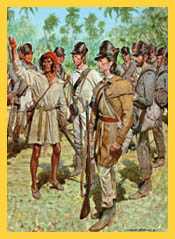
Brief history of service
On Christmas Day in 1837 the largest engagement of the war was fought on the shores of Lake Ockeechobee. Six companies of the 4th Inf. were under command of Colonel Zachary Taylor, First Infantry. In this engagement the regiment lost a total of 22 killed and/or wounded. By May of 1838 the regiment would leave for Tennessee to help in the removal of the Cherokee tribes there.
In 1841 the 4th Inf. would take place in the final campaign of the war. This campaign in the Everglades was to capture Chief Halleck Tustenuggee. This was successfully carried out and the regiment was transfered to Jefferson Barracks, Mo. in September of 1842. During the time spent in Florida the 4th Infantry suffered: 6 Officers killed in action or died of disease and 128 Enlisted men killed in action or died of disease.